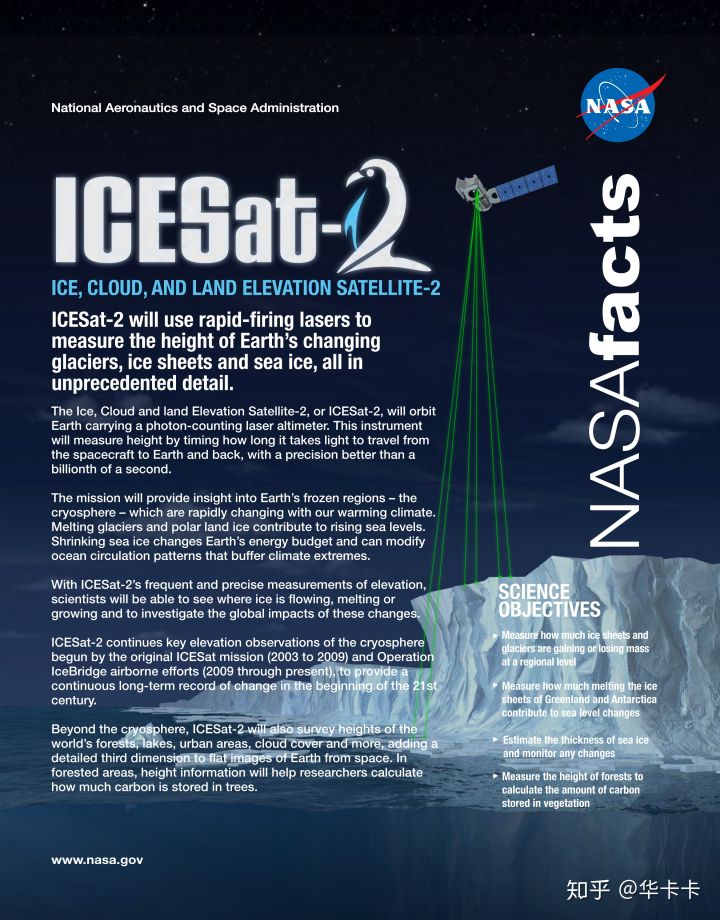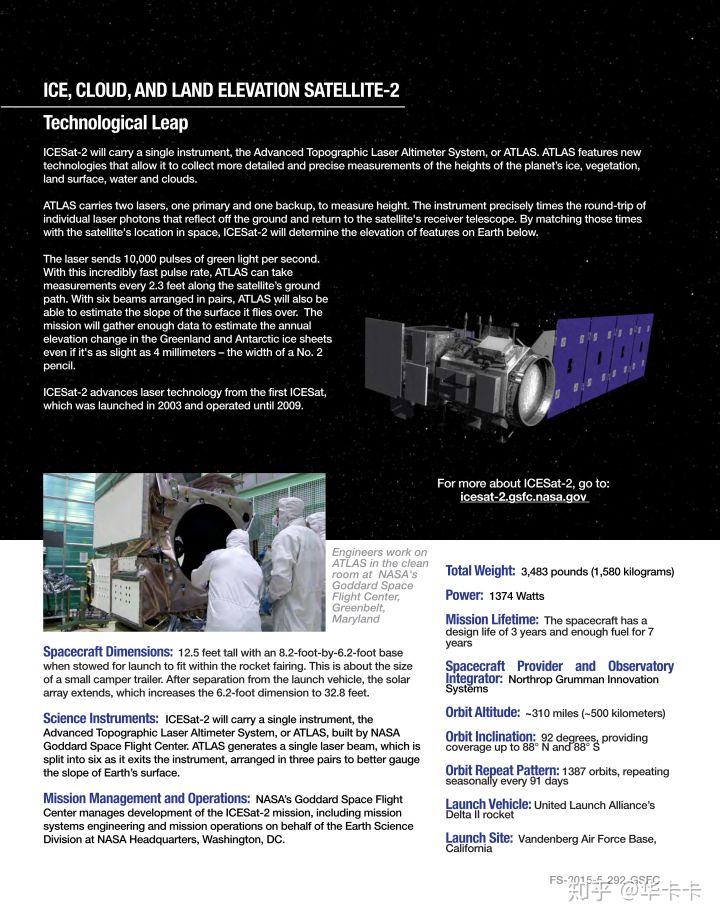ICESat-2
ICESat-2全称是Ice,Cloud and land Elevation Satellite -2。看名字我们能知道它的任务是测ice,cloud和land elevation,而且这是一个Satellite,是一颗卫星。那么这里我们就要分清ICESat-2和ATLAS的关系,ICESat-2是星载平台,是一个space observatory,ATLAS是这个星载平台上搭载的单光子激光雷达系统。ICESat-2有个-2在后面,这个是2nd generation的意思。既然有2nd generation,那么肯定就有1st generation,这个1st generation 就是ICESat(没有-2的后缀),ICESat-2是ICESat的升级版,它俩的任务都是测ice,cloud和land elevation(看名字也看得出来,一模一样)。ICESat从2003年一直工作到了2009年,采集了大量数据,现在已经退休了,其数据都挂在了下面这个NASA官网上。
NASA: ICESaticesat.gsfc.nasa.gov
现在的ICESat-2是2018年发射的,其相对于第一代ICESat有较大的升级,主要来说就是ICESat搭载的激光雷达是传统的激光雷达,是响应强度的,而ICESat-2搭载的是单光子激光雷达,是有单个光子响应能力的,极大扩展了探测性能。ICESat-2目前正在天上工作。
HOW IT WORKS
ICESat-2's spacecraft provides power, propulsion, orbit, navigation, data storage and handling, and more. It features an incredibly precise knowledge of the satellite’s position in space – critical for taking measurements.
这段话是NASA官网对ICESat-2功能的极简概括,ICESat-2提供电能,推进力,绕轨运动,导航,数据存储操作,定位等,也就是为ATLAS服务的平台。


贴两张NASA官网的宣传海报,这个海报基本概括了ICESat-2的主要特点,下面我针对海报内容做一些分析与解释。
ICESat-2 will use rapid-firing lasers to measure the height of Earth's changing glaciers, ice sheets and sea ice, all in unprecedented detail.
ICESat-2使用快速发射的激光来测量冰山冰层等,这个快速有多快呢?答案是10KHz重频的532nm激光器,这部分详情我将在ATLAS部分介绍。
The Ice, Cloud and land Elevation Satellite-2, or ICESat-2, will orbit Earth carrying a photon-counting laser altimeter. This instrument will measure height by timing how long it takes light to travel from the spacecraft to Earth and back, with a precision better than a billionth of a second.
ICESat-2搭载photon-counting laser altimeter,也就是光子计数激光测高仪。通常光子计数激光雷达和单光子激光雷达代表的是一个意思,即采用具有单个光子探测能力(或描述为具有光子计数能力)的探测器如APD、PMT、SNSPD(超导纳米线)组建而成的激光雷达系统,该系统记录的是光子离开和光子返回的时间,通过多次测量得到histogram来重建出距离信息,本质上也是TOF测距原理。NASA声称precision better than a billionth of a second,也就是精度可以达到ns量级(十亿分之一秒),根据光速300000000m/s可以得出1ns对应的距离是0.15m,也就是说该系统可以达到分米量级。考虑到ICESat-2的轨道高度约为500km,分米量级的精度已经算非常精确了。
ICESat-2 continues key elevation observations of the cryosphere begun by the original ICESat mission (2003 to 2009) and Operation IceBridge airborne efforts (2009 through present), to provide a continuous long-term record of change in the beginning of the 21st century.
如我前面所述,ICESat-2是ICESat的继任者,继续在space(空间,主要是指星载,和机载相对)观测低温区(南北极)冰层变化,同时NASA也有机载项目在监控冰层。
Spacecraft Dimensions: 12.5 feet tall with an 8.2-foot-by-6.2-foot base when stowed for launch to fit within the rocket fairing. This is about the size of a small camper trailer. After separation from the launch vehicle, the solar array extends, which increases the 6.2-foot dimension to 32.8 feet.
ICESat-2的尺寸:12.5英尺高,底座8.2英尺*6.2英尺,换算成公制就是3.81米高,底座2.50米*1.89米,和launch vehicle分离后会展开太阳板,从6.2英尺(1.89米)展到32.8英尺(10.00米)
Total Weight: 3,483 pounds (1,580 kilograms)
Power: 1374 Watts
Mission Lifetime: The spacecraft has a design life of 3 years and enough fuel for 7 years
Orbit Altitude: ~310 miles (~500 kilometers)
Orbit Inclination: 92 degrees, providing coverage up to 88° N and 88° S
Orbit Repeat Pattern: 1387 orbits, repeating seasonally every 91 days
Speed: 4.3 miles per second
Data: Onboard recorder stores 580 gigabits/day, X-band downlink sends 220Mbits a second.
Launch Vehicle: United Launch Alliance's Delta II rocket
Launch Site: Vandenberg Air Force Base, California
这些就是ICESat-2的基本信息,1.58吨重,功率1374瓦,设计寿命3年,燃料可供7年使用,轨道高度大约500km,轨道倾斜角92度,一共1387个轨道,每91天循环一次,对地速度4.3迈每秒(6.76km/s或24336km/h),每天记录数据580G,用X波段下传数据,速度为220Mbits/s(我们电脑下载常用的单位是KB/s,220Mbits/s=27.5MB/s)。